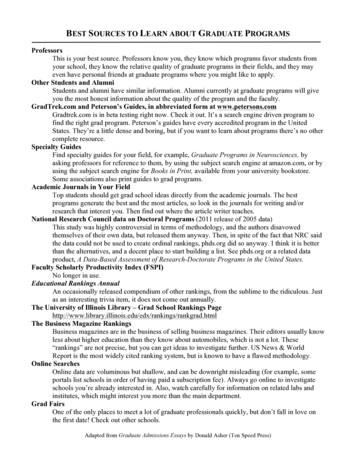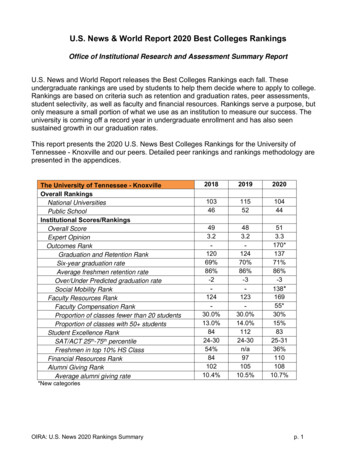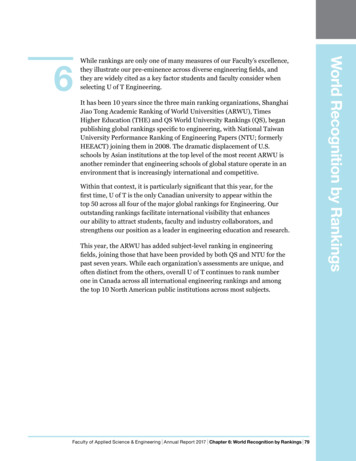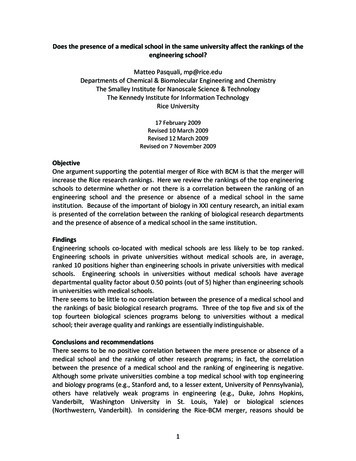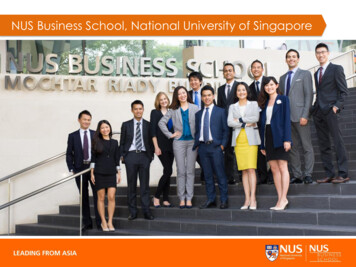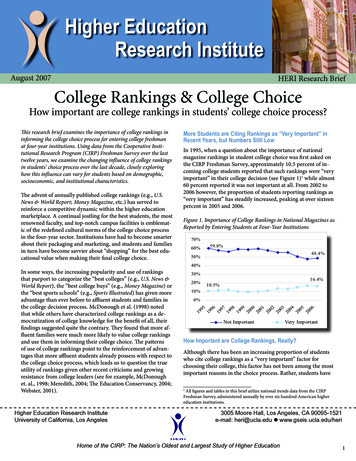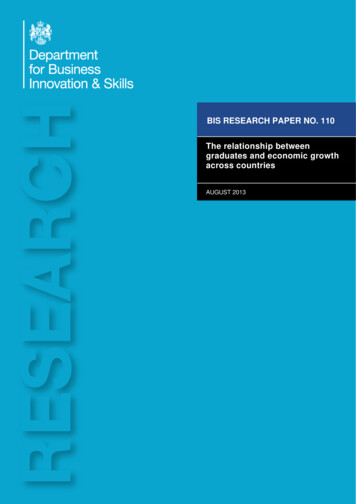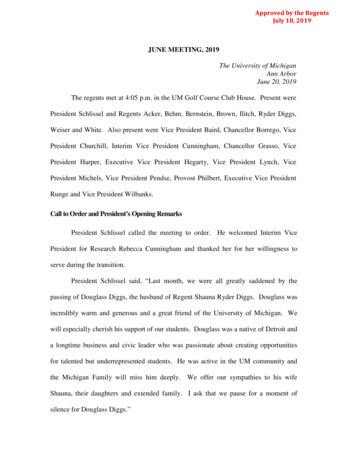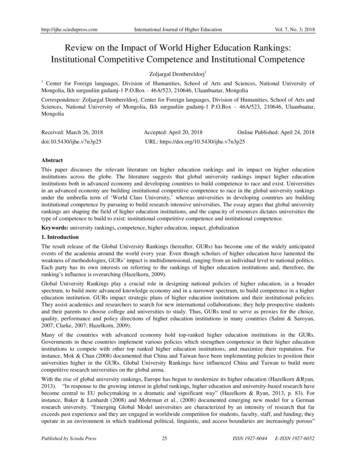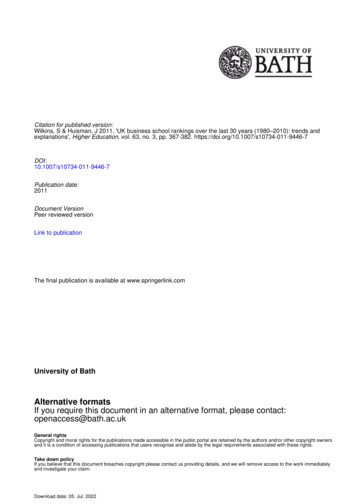
Transcription
Citation for published version:Wilkins, S & Huisman, J 2011, 'UK business school rankings over the last 30 years (1980–2010): trends andexplanations', Higher Education, vol. 63, no. 3, pp. 367-382. 07/s10734-011-9446-7Publication date:2011Document VersionPeer reviewed versionLink to publicationThe final publication is available at www.springerlink.comUniversity of BathAlternative formatsIf you require this document in an alternative format, please contact:openaccess@bath.ac.ukGeneral rightsCopyright and moral rights for the publications made accessible in the public portal are retained by the authors and/or other copyright ownersand it is a condition of accessing publications that users recognise and abide by the legal requirements associated with these rights.Take down policyIf you believe that this document breaches copyright please contact us providing details, and we will remove access to the work immediatelyand investigate your claim.Download date: 05. Jul. 2022
Wilkins, S. and Huisman, J. (2012). UK business school rankings over the last 30 years (1980-2010): trends and explanations.Higher Education, 63(3), 367-382.UK business school rankings over the last 30 years(1980-2010): trends and explanationsStephen Wilkins and Jeroen HuismanInternational Centre for Higher Education Management, School of Management,University of Bath, UKBusiness schools globally operate in a market-driven environment and rankings are verymuch part of that environment. Rankings have a significant impact on a school’s abilityto attract the top scholars, the most able students and research funding. Schools userankings to support claims of their excellence and ‘world class’ status. The purpose ofthis study is to explore whether an analysis of the historical development of businessschools and business/management education in the UK, supported by reference toinstitutional theory, can help explain trends in rankings and the positions of differenttypes of school. The analysis is based on a selection of undergraduate, MBA andresearch rankings published between 1984 and 2010. The findings of the study fit withthe expectations of institutional theory: particularly regulations and normative pathdependencies determined the rankings of different categories of university, e.g., ancient,plateglass, technology and post-1992.Keywords: rankings; league tables; business schools; business and managementeducation; historical analysis; institutional theoryIntroductionOver the last two decades, influential media rankings of business school teaching andresearch have appeared. In the UK, all of the broadsheet newspapers now produceuniversity or business school/MBA rankings. Most of these compare institutions on anational basis, but some, such as the Financial Times MBA ranking, compareinstitutions on a global basis.Governmental agencies also produce rankings, or provide data that allow others tobuild rankings. The Research Assessment Exercise (RAE), formerly the ResearchSelectivity Exercise (RSE), has assessed research in UK universities since 1986. Theresults of the last RAE, in 2008, were presented in the form of institutional profilesrather than a ranking, but the commercial media immediately converted the results intocomparative rankings.The approaches and methodologies employed by each ranking vary considerably(Stolz et al. 2010). However, the rankings do share a common approach, wherebyweighted aggregates of indicators are used to produce scores. Even though differentrankings can sometimes produce very different results (Bradshaw 2007, p. 54), rankingsappear to have secured public credibility and they significantly influence policy withinhigher education institutions (Marginson and Van der Wende 2007, p. 309; Hazelkorn,2011).The purpose of this study is to explore whether an analysis of the historicaldevelopment of business schools and business/management education in the UK,supported by reference to institutional theory, can explain trends in rankings and thepositions of different types of school. The study seeks to discover the extent to whichthe historical contingencies, and the events and situations that marked the developmentof management education in the UK, explain the rankings of individual business schools1
Wilkins, S. and Huisman, J. (2012). UK business school rankings over the last 30 years (1980-2010): trends and explanations.Higher Education, 63(3), 367-382.and the trends in rankings witnessed over the last three decades among schools indifferent categories of university.Theoretical frameworkInstitutional theory has become a popular tool to aid the study of organisations,including higher education institutions. Institutions might be recognised in organisationsand organisational fields as ‘the rules of the game’. Business schools can be regarded asbelonging to a distinct organisational field (DiMaggio and Powell 1983), where theschools, in aggregate, constitute a recognised area of institutional life, which includesstudents, regulatory agencies and competitors that also deliver business/managementprogrammes and/or conduct management research. As a distinct organisational field,business schools represent a suitable unit for analysis; business schools arguablycompete for largely the same resources and legitimacy, and operate under the sameinstitutional framework in terms of laws, regulations, normative rules and cognitivebelief systems (Wedlin 2006).Scott (2008) claims that in order to survive organisations must conform to the rulesand belief systems prevailing in the environment, so that organisational legitimacy canbe achieved. Scott (2008, p. 48) suggests that institutions consist of regulative,normative and cultural-cognitive elements or pillars that, together with the associatedactivities and resources, provide stability and meaning to social life. Each of the pillarsprovides a basis by which organisations can achieve legitimacy, and as organisationsfollow the ‘rules of the game’, isomorphic behaviour and actions within organisationalfields result.Impacts of rankings on business schoolsDespite their methodological flaws, business school rankings provide prospectivestudents with an information resource that helps them choose the programme that bestsatisfies their needs and wants. Research has shown how an improvement in a school’sranking can lead to dramatic increases in applications in following years (Peters 2007,p. 49). Surveys have found that school rankings have more influence on the decisionmaking process of MBA applicants than any other media source (Tyson 2001). Thebusiness schools with the highest rankings are also able to attract the highest qualitystudents and to command the highest prices for their services (Fombrun 1996). There isa clear relationship between school rankings and student performance (Elbeck 2009, p.84), and, upon graduation, students from the top schools secure the highest paid jobs.High ranked schools are able to attract the top scholars and higher levels of researchincome, which will boost their research performance (see also Gioia and Corley 2002).Apart from ranking positions, business schools seek other ways to have theirqualities externally confirmed. Some schools have their learning standards assured byaccreditation. The criteria and requirements of accreditation bodies might be regarded aspart of the regulative frame, but by becoming a norm that is expected by stakeholders,accreditation also forms part of the normative pillar. Achieving accreditation, therefore,is another ‘rule of the game’ in management education. It undeniably ties in withranking, for employers are more likely to sponsor candidates on programmes that havetheir learning standards externally accredited and they are also likely to recruit moregraduates from such programmes.In summary, higher ranked schools attract the top scholars, the best candidatespaying the highest tuition fees, and the most external funding, which enables many ofthese schools to deliver the highest standards of learning and produce the highest qualitygraduates. All of these things contribute to higher ranked schools maintaining theirfavourable positions in rankings in the long term.2
Wilkins, S. and Huisman, J. (2012). UK business school rankings over the last 30 years (1980-2010): trends and explanations.Higher Education, 63(3), 367-382.Business schools and the market-driven environmentResearch has found that managers in high ranked schools generally believe thatrankings are valid (Martins 1998), and that high ranked institutions can seldom resistthe temptation to cite the league tables of national newspapers (HEFCE 2008, p. 8). Ofthe 100 schools listed in the Financial Times global ranking of MBAs in 2006, 96schools referred to their position on their websites, in press releases or in literature theyproduced (Bradshaw 2007, p. 54). Rankings are increasingly being used to supportclaims by institutions of their excellence.Most UK business schools appreciate that rankings have an impact on theirreputations and the number and quality of applicants they receive, and they setobjectives and implement strategies to improve their positions in league tables. Martins(1998) found that ranked schools took more action than unranked schools to address theissues that could improve their rankings, while unranked schools were more likely todispute the validity of rankings and took no decisive actions to improve their positionsin rankings. Some universities simply refuse to ‘play the game’, and request not to beincluded in rankings (The Independent 2009). According to institutional theory,organisations that do not follow the ‘rules of the game’ face the loss of organisationallegitimacy. Therefore, most business schools feel the need to ‘play’ the rankings game(Wedlin 2006). So far, all evidence would point in the direction of business schoolsbeing driven to conform to the expectations expounded in rankings (and accreditationmechanisms). Theoretically, these expectations are regulative and normative reflectionsof external legitimacy and business schools neglecting these signs run the risk of beingillegitimate and – to stick to the metaphor – to lose the game. Indeed, researchers havefound that rankings act as sources of institutional isomorphic pressure on organisations(Fombrun and Shanley 1990; Deephouse 2000; Gioia and Corley 2002). There seems tobe a consensus in the literature that rankings are sources of normative pressure onorganisations that push them to conform to the criteria used by the rankings (Martins2005, p. 702).Institutional theory has been criticised for portraying organisations as pawns, anddownplaying agency (Dacin 1997; Heugens and Lander 2009). One difficult to explainfact is that some UK universities and business schools apparently can survive withoutplaying the game. Bringing agency on board helps explain particular dynamics inorganisational fields, while the expectation of isomorphism within those fields can beretained. Not only strategies of individual business schools can have an impact on theirrankings, so too can government policies that affect the general rules of the game: e.g.,decisions on levels of funding for teaching and research, and how performance inteaching and research is assessed. As we will argue below, these regulative forces andhistorical-political path dependencies have been very strong in the UK higher educationsystem. It has led to a fairly stable system in terms of positions of individual schools,confirming the idea that ranking results have impact that further strengthen legitimacy,status and consequently ranking positions. It has not, however, led to a field of businessschools where each individual member tries to emulate the highest ranked businessschools. A clearly stratified system of business schools emerged. The large historicallygiven differences in the starting positions of the different business schools actually donot allow all the business schools to play the same game. Strategic games and upwardmobility are only to a limited extent possible within the rather tight environmentalcontexts into which the business schools were born. It is therefore hypothesised thatbusiness schools in different types of university – such as ancient, plateglass,technology and post-1992 – adopt the behaviour and actions of other schools in thesame category of university.3
Wilkins, S. and Huisman, J. (2012). UK business school rankings over the last 30 years (1980-2010): trends and explanations.Higher Education, 63(3), 367-382.MethodThe empirical evidence for the historical analysis was obtained from a literature searchthat included books, academic journals, trade journals, newspapers, government andresearch organisation reports, and university reports and websites. Adopting a historicalapproach – focusing on the emergence of business/management as an academicdiscipline, the role of founding fathers in the field and the role of policies in shaping thehigher education system – allows us, with hindsight, to better appreciate and understandthe effects and outcomes of events, decisions and approaches that took place in the past.This study examines undergraduate, MBA and research rankings. To analyse theperformance of business schools with regard to their undergraduate programmes, TheTimes ranking (first appearing in 1992) has been chosen, as the book in which it ispublished is the best selling university guide and, therefore, it is the ranking mostreferred to by sixth form students (years 12 and 13) when deciding where to apply. Asurvey of leaders and administrators in English universities found that The Times wasbelieved to be the most influential league table (HEFCE 2008, p. 32).Prior to 1992, a few rankings of teaching and research in UK business schools werepublished, but they were based on peer group reviews, i.e., deans of schools rankingother schools, which are now sometimes referred to as ‘beauty contests’ (Davies andSalterio 2007, p. 96). This study uses one such peer review as its point of departure. TheUniversity Grants Committee (UGC) published a report in 1984 that included rankingsfor teaching and research in business schools, and these rankings were reproduced in theTimes Higher Educational Supplement (Paliwoda and Harrison 1988, p. 32).To analyse the quality of MBAs offered at different business schools, the FinancialTimes ranking has been chosen (first appearing in 1999), as it is widely believed to bethe most influential and prestigious (Williams 2010, p. 71). Although the FinancialTimes produces several rankings, this study refers only to the global full-time MBAranking, which is the one most often quoted in the media and by the schools themselves.Finally, the research performance of the schools is analysed using the results of theRAE assessments of 1992, 2001 and 2008. The RAE is an exercise undertaken everyfew years, organised on behalf of the four UK higher education funding councils. Asubject specialist peer review panel assesses each subject area. Business andManagement Studies is the unit of assessment examined in this study. The results of theRAEs determine the amount of research funding that each UK university receives, andthey are also used as indicators in The Times and Financial Times rankings. The results,therefore, have a significant impact on the reputations and perceived quality of thedifferent schools.A random-convenience approach was adopted to select the years in which thedifferent rankings were examined. A gap of at least seven years between any tworankings was ensured, to provide a clearer picture of the trends in rankings between1984 and 2010. Then, a descriptive historical analysis of the development of businessschools and business/management education in the UK was undertaken in an attempt toexplain the trends in rankings and the positions of individual schools at various timesduring the period under examination.The ranking tables (Tables 1-3) show the names of institutions as at the end of 2010.Institutions that achieved a top 5 ranking in any year are shown in bold face, in order togive an indication as to which schools were considered among the elite in any givenyear. The cut-off points for each ranking were chosen according to data availability - forexample, The Times undergraduate ranking of 1994 lists only 22 institutions - andaccording to spread, i.e., the number of UK institutions in the top 20, 30, 100 etc., so asto best capture the patterns that we wanted to analyse.4
Wilkins, S. and Huisman, J. (2012). UK business school rankings over the last 30 years (1980-2010): trends and explanations.Higher Education, 63(3), 367-382.Business and management education in the UK before 1980The British Institute of Management and the Ministry of Education launched theDiploma in Management (DMS) a few years after the Second World War. By the late1960s, the DMS was offered at many polytechnics and colleges of higher education.These institutions were the pioneers of management studies in the UK, as before the1960s few universities had shown any significant interest in management education(Platt 1969, p. 7).The DMS enabled the polytechnics and colleges of higher education to develop theirexpertise in delivering management education, and by the late 1980s approximately7,700 candidates were taking the qualification (Williams 2010, p. 28). Of the 41institutions listed in the UGC teaching ranking of 1984 (ignoring three institutions thatoffered only graduate programmes), 18 were polytechnics or colleges of highereducation (Paliwoda and Harrison, 1988). Furthermore, several polytechnics achievedhigher rankings than Imperial College London and the London School of Economics.The ‘revolution’ in management education in the late 1960sAround the same time (post-Second World War), there was a realisation among a groupof individuals and institutions that the UK’s productivity lagged far behind some of itsglobal competitors and that poor management performance was largely to blame. Underthe Marshall Plan, America supplied the UK with financial and technical assistance(Tiratsoo 1998). Beneficiaries included Loughborough College (later LoughboroughUniversity), Cambridge, Warwick and the London Business School.In 1960, a small group of men from the worlds of politics, industry and educationestablished the Foundation for Management Education (FME) in order to promote thedevelopment of management education and research in the UK. A major activity of theFME was fundraising, in order to provide grants for the establishment ofbusiness/management schools at universities and the development of managementprogrammes. In the period 1960-84, the largest recipients of grants from the FME (inrank order) were London Business School, Manchester Business School, Bradford,Strathclyde, Aston, Warwick, Imperial College London and Cranfield (Nind 1985, p.84). Each of these institutions feature in the top 20 of the UGC teaching and researchrankings published in 1984 (Tables 2 and 3). Access to substantial external funding tosupport their various initiatives and first-mover advantage, such as the ability toestablish their brands and reputations, were obviously factors that contributed to theearly success of several schools in rankings. Most projects were successful, even thoughmany in academia were cautious about the introduction of vocationally-orientatedcourses for business and commerce.Two influential reports appeared in 1963, providing the stimuli for the ‘revolution’in management education. The first was the Robbins Report (Robbins 1963), whichrecommended that the Colleges of Advanced Technology should be given universitystatus and that two postgraduate schools of management should be established. Thesecond was the Franks Report (Franks 1963). Franks described the need for high qualitybusiness schools, the environment in which they should be set, the constitution onwhich they should be based, the students and courses to be designed for them, and howthey should be staffed and financed (Nind 1985, p. 21). The result was the founding oftwo business schools, one in London and one in Manchester.London and ManchesterThe London (LBS) and Manchester (MBS) Business Schools were established in 1965.Both schools operated with a high degree of autonomy. It was expected that LBS andMBS would become national institutions of excellence for management teaching and5
Wilkins, S. and Huisman, J. (2012). UK business school rankings over the last 30 years (1980-2010): trends and explanations.Higher Education, 63(3), 367-382.research. LBS recruited high quality faculty, who were given substantial freedom todevelop their own research agendas (Ball 1979, p. 4). This strategy was successful inencouraging the production of innovative, cutting-edge research. LBS was alsosuccessful in obtaining a high proportion of its research income from industry,commerce and various grant-awarding institutions. Like LBS, MBS adopted ademocratic, decentralised style of management and it introduced a highly practical,learning-by-doing approach to management education.The plateglass and technology universitiesThe government initiative to expand access to higher education saw 20 new universitiescreated between 1961 and 1968. Ten of the newly created universities had previouslybeen Colleges of Advanced Technology (CATs), such as Aston, Bath, Bradford, Cityand Loughborough. Having offered the DMS, several of the CATs had experience ofdelivering management programmes, and in 1968, four of the newly establisheduniversities were also delivering the DMS (Platt 1969, p. 62). Beloff (1968) coined theterm ‘plateglass university’ to refer to seven newly established greenfield campusuniversities, including Lancaster and Warwick, which had architectural designs thatcontained wide expanses of plate glass in steel or concrete frames.It was, perhaps, the technological and engineering backgrounds of the ex-CATs thatencouraged them to develop management programmes. By 1968, 25 universities wereseriously committed to establishing a business school (Platt 1969, p. 13), and theseincluded most of the ex-CATs and also some of the plateglass universities. It could besaid that among the ex-CAT and plateglass universities there was an isomorphic rush toestablish business schools.Many of the ex-CATs already had good relationships with industry and favourablereputations with both students and employers. It was relatively easy for them to launchattractive management programmes. Most of the plateglass and ex-CAT universitieswere committed from the start of their existences to achieving strong research bases.The plateglass universities generally enjoyed good fortune in having modern buildings,the best equipment and resources, and the ability to recruit high calibre research activestaff. In the 1984 UGC ranking for research in business and management studies (Table3), five of the top 10 institutions were plateglass or ex-CATs, and the top fourinstitutions for teaching were all institutions established or designated as universities inthe 1960s.The PolytechnicsIn 1965, the UK government announced its intention to implement a ‘binary policy’ inhigher education in England, Wales and Northern Ireland, with distinct university andnon-university sectors. The universities were to concentrate on providing academicprogrammes while the polytechnics would provide professional and vocationalprogrammes. The contribution of polytechnics to the development of business andmanagement education in England and Wales should not be underestimated. The DMSattracted far more candidates during the 1980s. In addition, the polytechnics offered theHigher National Diploma (HND) in Business and the BA in Business Studies. Thebachelor degree, accredited by the Council for National Academic Awards (CNAA),became one of the most popular undergraduate degrees in England and Wales (Pratt1997). It was a four-year sandwich course that required the completion of a one-yearwork placement in industry.Students benefited from experiencing work in a particular industry, and a highproportion secured employment post graduation with the employer that had providedtheir work placement(s). The credibility of the BA in Business Studies qualification was6
Wilkins, S. and Huisman, J. (2012). UK business school rankings over the last 30 years (1980-2010): trends and explanations.Higher Education, 63(3), 367-382.helped by the fact that it was recognised by professional bodies to achieve membership,such as the Chartered Institute of Marketing and the Chartered Institute of Personneland Development.In general, the polytechnics gained reputations for strong teaching in BusinessStudies and Management. In the UGC 1984 ranking for teaching, eight of the top 25institutions were polytechnics, with Kingston placed the highest at 14th (Tables 1 and 2).The polytechnics did not receive public funding for research, and therefore research wasnever a priority in most polytechnics. It should not be a surprise, therefore, that thepolytechnics do not feature among the top 10 in rankings for research in business andmanagement.Business and management education and research since 1980The number of students taking business and management degrees increased more thanany other subject area during the 1980s and 1990s. In 2010, there were over 250,000full-time equivalent students taking a business or management programme, whichaccounted for 15% of all students in UK higher education (Williams 2010, ix). Thepolytechnics were the main providers of undergraduate Business programmes,accounting for three-quarters of all places, whilst the universities were the mainproviders of MBAs, postgraduate programmes and research. The blurring of the binarydivide became more noticeable during the 1980s as university business schoolsintroduced undergraduate programmes and the polytechnics introduced MBAprogrammes. The nature of the provision at polytechnics and universities also changed,with the polytechnics becoming more academic and the universities, in some cases,becoming more vocational.Undergraduate programmesIn The Times 1994 undergraduate ranking each indicator (entry standards, staffinglevels, completion rates, and funding council teaching and research ratings) were givenequal weighting (O’ Leary and Cannon 1994, p. 44). Most of the plateglass and exCATs that achieved high positions in undergraduate rankings in the 1980s continued toperform well during the following two decades. In The Times 2010 ranking, eight of thetwenty universities established in the 1960s achieved places in the top 20. During theperiod from 1984 to 2010, the most consistent high performers were Bath, Lancasterand Warwick (Table 1). Bath is the only university to achieve a top 5 position in all ofthe years examined. The biggest ‘under-achievers’ among the ex-CAT universitiesduring the same period are Bradford, falling from 4th place to joint 59th and Salfordfalling from 18th place to joint 59th. Both institutions are located in towns that might beregarded as less attractive by many UK students. The fall of Bradford in undergraduaterankings might also be explained in part by its decline in research rankings, given thatresearch is an indicator in The Times undergraduate rankings.After 1998, the Quality Assurance Agency (QAA), using its Teaching QualityAssessment (TQA), was responsible for assessing the quality of teaching in universities.Despite widespread criticisms of its methodology (Laughton 2003), there was lessopposition from the polytechnics, as they probably believed that the TQA would enablethem to demonstrate what they considered they did best, i.e., teaching. The earlier TQAsproduced ratings such as Excellent, Highly Satisfactory or Satisfactory, whilst laterTQAs resulted in a score, with 24 being the maximum. During the period 1997-2001,many of the polytechnics did indeed achieve high teaching quality assessments. Forexample, De Montfort, Glamorgan, Kingston, Northumbria, Nottingham Trent andWest of England achieved ‘excellent’ ratings, whilst Aston, Bradford, Cardiff andKing’s College achieved only ‘satisfactory’ ratings (O’ Leary et al. 2001, p. 62).7
Wilkins, S. and Huisman, J. (2012). UK business school rankings over the last 30 years (1980-2010): trends and explanations.Higher Education, 63(3), 367-382.Table 1 UK business school rankings for undergraduate Business Studies mouthSheffield HallamEast AngliaNottingham TrentUlsterMiddlesexLeeds MetropolitanImperial College LondonSheffieldLondon School of EconomicsNottinghamBirminghamOxfordSt AndrewsHullSurreyRoyal Holloway LondonDe MontfortWest of EnglandLeedsCambridgeExeterKing’s College LondonLeicesterSussex1984a12345678111214151617 18 18 18 18 18 18 18 25 25 25 25 25 251994b 41 4 42 9 15 11 15 7 152001c5243018121134916 7 11 152650427744645962411948736110273631361743 14 1418202832374051 15 153 91314 15 152010d468 591711325141367332021257953 595650304763106983221012191740313639 591729161518Notes: Universities that achieved a top five ranking in at least one year are shown in bold face.aUniversity Grants Committee (UGC) Report, 1984, in Paliwoda and Harrison (1988). TheAssociation of MBAs Guide to Business Schools, 7th edition. This ranking includes bothundergraduate and postgraduate teaching. Business schools that delivered only postgraduateprogrammes have been omitted (Manchester and London Business Schools, which held 9 th and10th positions respectively, and Cranfield in 13th position). The University of Manchester8
Wilkins, S. and Huisman, J. (2012). UK business school rankings over the last 30 years (1980-2010): trends and explanations.Higher Education, 63(3), 367-382.Institute of Science and Technology (UMIST), now part of the University of Manch
rather than a ranking, but the commercial media immediately converted the results into . UK business school rankings over the last 30 years (1980-2010): trends and explanations. Higher Education, 63(3), 367-382. 2 and the trends in rankings witnessed over the last three decades among schools in different categories of university. .
